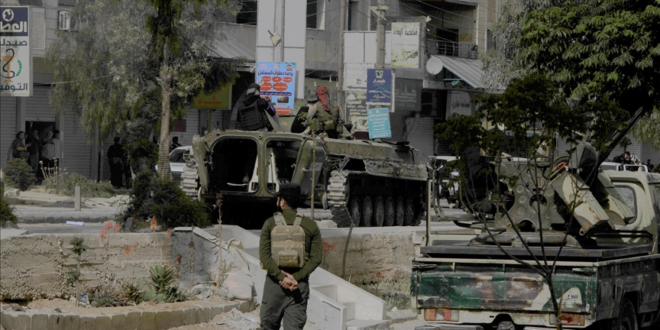The eruption of violence in Ashrafiyet Sahnaya and surrounding areas has exposed the profound failures of the Syrian state to protect its citizens—especially its minorities—in the supposed aftermath of dictatorship. Far from being an isolated flare-up, the events represent a deepening crisis rooted in sectarian marginalisation, government negligence, and a security apparatus that has once again proven more adept at repression than protection.
I. A Manufactured Crisis: From a Rumour to Bloodshed
The official narrative pins the crisis on a voice recording from Jaramana, allegedly containing blasphemous content attributed to a Druze individual. While the authenticity of the recording remains unverified—and leading Druze clerics swiftly condemned its content—the regime allowed outrage to spiral unchecked. Rather than defuse tensions through transparent investigation or intercommunal dialogue, the state remained conspicuously absent, tacitly permitting polarisation to fester.
In a country still bleeding from years of war, where minorities are routinely scapegoated to deflect from systemic decay, the blasphemy rumour was not just a spark—it was a pretext. A pretext that laid bare the government’s ongoing instrumentalisation of sectarian fear for political gain.
II. Breakdown by Design: Violence in Ashrafiyet Sahnaya
Within hours, violence spread to Ashrafiyet Sahnaya. Armed assailants, whose identities remain suspiciously vague, launched coordinated attacks on government checkpoints. At least 16 members of the General Security Directorate were killed. Reports suggest several of the victims were Druze—a detail the government has conspicuously downplayed, raising questions about internal fractures and sectarian fault lines within state institutions themselves.
Civilian accounts speak of deserted streets, blackouts, and paralysing fear. Rather than protect residents or address root causes, the Interior Ministry responded with familiar brute force: deploying drone battalions and flooding the area with troops. These measures, typically reserved for suppressing dissent, only deepened the public’s sense that the state is more interested in controlling territory than safeguarding lives—especially the lives of those it deems politically expendable.
III. Israel’s Calculated Entry: Protection or Provocation?
Israel’s airstrikes on Ashrafiyet Sahnaya, carried out under the pretext of defending the Druze, were met with the usual Syrian outrage. Yet these denunciations ring hollow when Damascus itself has shown such disregard for the wellbeing of its own Druze citizens. The fact that Israel’s justification—that it sought to prevent an imminent massacre—was not immediately discredited by regional actors speaks volumes about the erosion of trust in the Syrian state’s ability to protect its people.
More troubling is that the Israeli strikes appeared precisely timed. Just hours before, Sheikh Mowafaq Tarif, the spiritual leader of Druze in Israel, met with senior Israeli military officials. The Syrian government, meanwhile, had offered no visible reassurances to the Druze—only silence, force, and ambiguity.
IV. Druze Leadership Fills the Vacuum
With the state abdicating its responsibilities, it was the Druze leadership from Sweida who stepped in to mediate and stabilise the situation. Figures like Sheikhs Hammoud al-Hanawi, Yousef Jarboua, and leaders of the Men of Dignity movement travelled to Daraya to secure a ceasefire, broker a withdrawal of military forces, and restore calm to the region.
Their success in preventing further escalation underscores a bitter truth: the Syrian state is no longer perceived as a neutral guarantor of public safety, especially for marginalised communities. It is local leaders—not state authorities—who are now the de facto crisis managers in large swathes of the country.
Even Sheikh Suleiman Abdel-Baqi, a respected Druze leader, pointed the finger at extremist elements “recently embedded” in Syria’s security services—raising the possibility of state-sanctioned provocation aimed at igniting conflict for political leverage.
V. Sovereignty as Cover for Repression
In a tone-deaf response to calls for protection and accountability, the Ministry of Foreign Affairs issued a statement denouncing any suggestion of international involvement as an attack on Syria’s sovereignty. Yet this defence of sovereignty rings empty when the state itself fails to exercise sovereignty in service of its citizens’ safety or dignity.
The regime’s invocation of “unity” and “national fabric” rings especially hollow in light of its track record—one that has consistently prioritised the survival of the security elite over the pluralism and protection of Syria’s rich societal mosaic.
VI. Implications for Syria’s Transition: A Fragile, Exclusionary State
The crisis in Ashrafiyet Sahnaya reveals not only a fractured security architecture but also a post-Assad Syria that risks reproducing the same exclusionary logic of the past. Key takeaways include:
A Security State Without a Social Contract: The state’s default reliance on military solutions and mass deployment—absent trust, transparency, or inclusion—signals a continuation of authoritarian governance by other means.
Marginalised Minorities, Selective Inclusion: The Druze are praised in official rhetoric as part of Syria’s national fabric, yet in practice, they are excluded from meaningful protection and only engaged with when their patience threatens to run out.
Israel as a Strategic Intervener: While Israel’s actions constitute a breach of Syrian sovereignty, their appeal to humanitarian logic exposes Damascus’s moral and practical vacuum in minority protection.
Regional Ramifications: With Turkey, Israel, and Lebanon’s Druze community reacting in parallel, the events may presage a new phase in the regional contest over Syria’s political identity—between federalism, centralised control, and confessional power-sharing.VII. Conclusion: A State at War with Its Own Foundations
What unfolded in Ashrafiyet Sahnaya is not an aberration—it is the inevitable outcome of a political order that refuses reform and treats pluralism as a threat rather than a strength. The state has once again proven more effective at projecting power than earning legitimacy.
If Syria’s transition is to have any meaning beyond cosmetic change, it must confront its ingrained hostility to minority agency, rebuild broken channels of trust, and relinquish the violent reflexes that brought it to the brink in the first place.
Without such reckoning, Ashrafiyet Sahnaya may not be a warning—it may be a preview
 Eurasia Press & News
Eurasia Press & News


